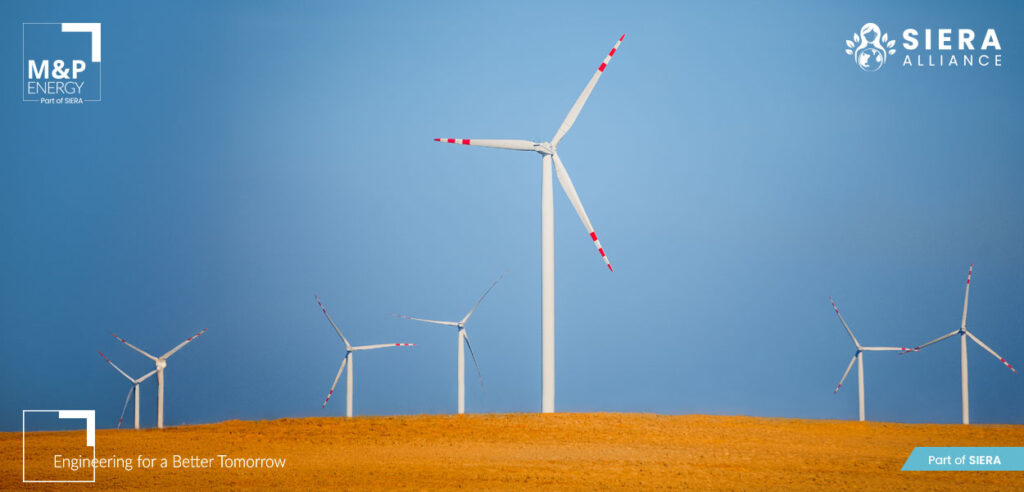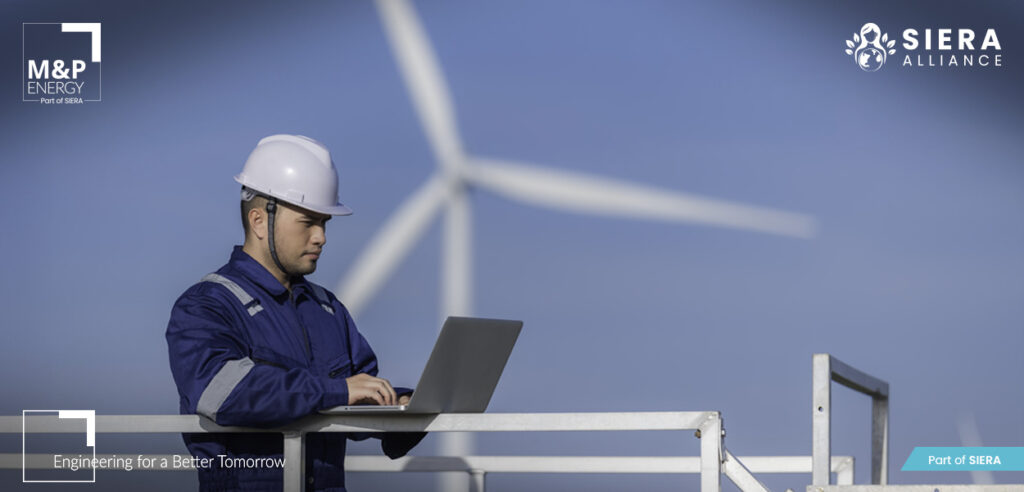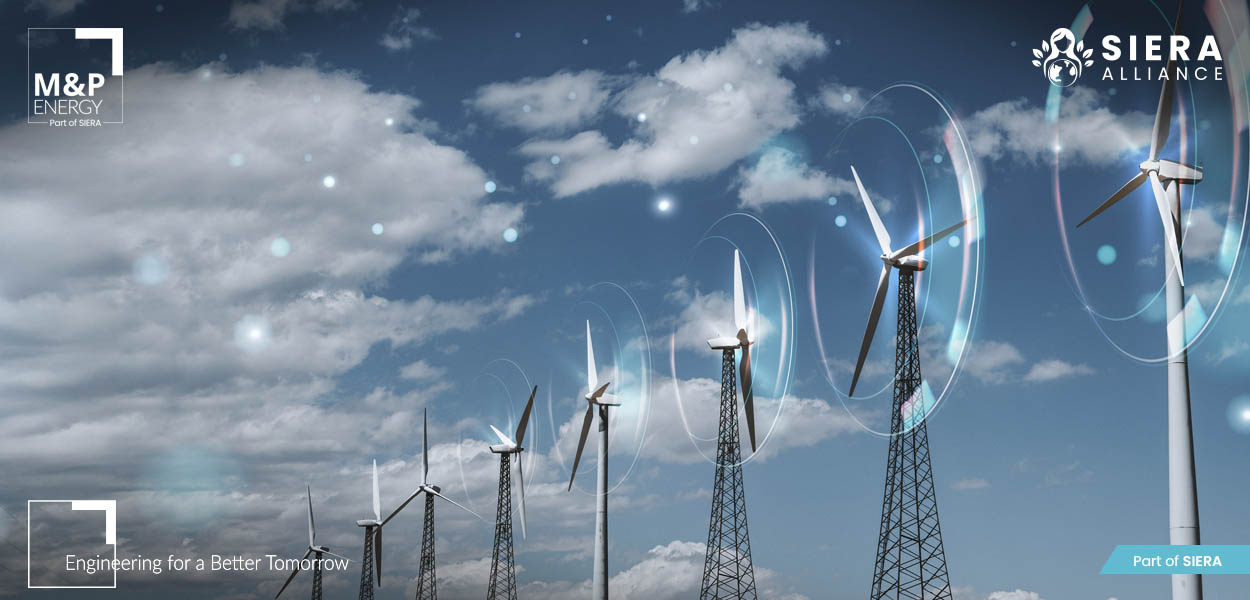As the world confronts the twin crises of climate change and energy insecurity, the shift toward clean energy has become more urgent than ever before. Among the most promising renewable energy sources, wind powerstands out as a reliable, scalable and eco-friendly alternative to fossil fuels.
Free from carbon emissions, water consumption and toxic byproducts, wind energy harnesses the natural movement of air to generate electricity. Recognizing the potential of wind energy to revolutionize the global power supply and bring about a more sustainable future, MuP Energy, part of SIERA, will explore the key definitions, leading strategies and essential considerations associated with wind power in this article.
What Is Wind Power?
Wind power is the process of converting the kinetic energy of moving air into mechanical or electrical energy using wind turbines. These tall, sleek machines capture the momentum of wind and turn it into usable electricity. Since it depends on natural atmospheric movement — ultimately driven by the sun — wind power is not only renewable, it is inexhaustible.
Furthermore, unlike coal or gas, wind power emits no pollutants during operation. It’s also incredibly versatile as wind energy systems can power individual homes, small businesses or even entire cities. Whether deployed onshore or offshore, wind power is playing a crucial role in the clean energy transition.
How Wind Turbines Work
Understanding the workings of wind turbines helps demystify this important technology. A modern wind turbine typically features three blades that are mounted on a rotor and connected to a shaft inside the nacelle (the box at the top of the tower).
Here’s a simplified breakdown of how wind turbines generate power:
- Blades capture wind energy: As wind moves over the blades, it creates lift (like an airplane wing), causing them to spin.
- Rotor turns a shaft: The spinning rotor is attached to a shaft that turns inside the nacelle.
- Generator produces electricity: This mechanical rotation drives a generator that converts kinetic energy into electrical energy.
- Electricity is transmitted: The electricity is then sent through cables to substations and finally into the public power grid.
Modern turbines can reach heights of over 100 meters, with blades up to 80 meters long. Offshore turbines are even larger and more powerful, capable of generating over 12 MW of electricity — enough to power 5,000+ homes annually.
Types of Wind Power Systems
Wind energy systems vary in size, location and application. These are the primary types:
1. Onshore Wind Power Systems
Typically installed in open plains, hilltops or agricultural areas with reliable and abundant wind patterns, onshore wind power systems are favored for their relatively low installation and maintenance costs, along with their ease of connection to existing power grids. The average onshore wind turbine generates between 2,000 to 3,000 kilowatts of energy. However, onshore turbines sometimes face pushback over land use conflicts, occasionally raising concerns about the noise pollution suffered by nearby communities.
2. Offshore Wind Power Systems
Constructed in bodies of water, offshore wind power systems can harness stronger and more consistent winds, resulting in average energy yields of 8,000 to 10,000 kilowatts. Furthermore, since they are usually several kilometers from the coast, offshore turbines can avoid the land use conflicts and pollution complaints associated with their onshore counterparts. The trade-off, however, lies in the higher costs of installation and the logistical challenges of maintaining equipment in marine environments.
3. Small or Distributed Wind Systems
Small or distributed wind systems are designed for localized use, such as powering individual homes, farms or small businesses. These systems typically generate less than 100 kilowatts of power and are well-suited for rural or off-grid areas where access to the main grid is limited. They help smaller communities reduce reliance on centralized power sources, though their effectiveness depends heavily on favorable wind conditions.
4. Hybrid Wind Systems
Integrated with other renewable energy sources like solar panels or battery storage, hybrid wind systems offer a more reliable and balanced power supply. They are especially useful in microgrid applications or in areas with variable energy resources. By combining technologies, they enhance energy availability and resilience. However, hybrid systems also involve more complex planning and system integration, which can increase initial investment and technical requirements.

Onshore vs Offshore Wind Systems
| Feature | Onshore Wind Systems | Offshore Wind Systems |
| Location | Land (plains, hills, agricultural zones) | Bodies of water, several kilometers off the coast |
| Wind Speed | Moderate and more variable | Stronger and more consistent |
| Installation Cost | Relatively lower | Higher due to marine construction |
| Maintenance | Easier and more accessible | Complex and costly due to remote location |
| Land Use Impact | May conflict with agriculture, residences or wildlife | Minimal land-use conflict |
| Visual/Noise Impact | Higher (closer to population centers) | Lower (distant from shore) |
| Grid Connection | Easier and more direct | Requires undersea cabling and specialized infrastructure |
| Average Power Yield | 2–3 megawatts (MW) per turbine | 8–10 megawatts (MW) per turbine |
A balanced mix of onshore and offshore wind systems creates a robust, diversified renewable energy grid.
The Advantages of Wind Energy
Wind power offers a broad range of environmental, economic and social benefits:
1. Clean And Renewable
Wind energy emits no greenhouse gases during operation and doesn’t release any other pollutants into the surrounding air or water, making it one of the cleanest energy sources available.
2. Low Operating Costs
Once a turbine is installed, its operational costs are minimal. Maintenance is predictable and wind is free.
3. Energy Independence
Developing local wind resources can help countries reduce reliance on imported fossil fuels by, thereby enhancing national energy security.
4. Job Creation
From manufacturing and logistics to construction and maintenance, the wind industry supports over 1.4 million jobs globally.

Wind Power in the Global Energy Transition
In 2022 alone, wind contributed 7.5% of the world’s electricity generation. By 2023, global wind energy capacity had surpassed 1,000 gigawatts, marking a significant milestone in renewable energy deployment.
Moving forward, wind power will continue to be a focal point of global clean energy solutions as its rapid scalability and low environmental impact make it an essential part of the energy mix for both, industrialized and developing economies. Furthermore, wind energy also plays a critical role in decarbonization.
A single 2-megawatt turbine can prevent more than 4,000 tons of CO₂ emissions each year. When combined with solar energy and storage systems, wind power helps lay the foundation for a resilient, low-carbon electricity grid.
Challenges and Limitations of Wind Power
Despite its many benefits, wind turbine energy isn’t without obstacles:
1. Intermittency
Wind doesn’t blow consistently. Turbines often run at 30-45% capacity, requiring energy storage or hybrid systems for stable supply.
2. High Upfront Costs
Installation — especially offshore — requires substantial capital. However, long-term savings often offset these investments.
3. Visual and Acoustic Impact
Some communities find turbines visually intrusive or noisy, though modern designs aim to reduce both.
4. Wildlife Concerns
Poorly located wind farms can affect bird and bat populations. Environmental impact assessments and new technologies help mitigate these effects.
5. Land And Access Issues
Onshore turbines need large open areas. In densely populated or forested regions, land access may be limited. Offshore solutions bypass this but introduce logistical challenges.
Power Your Future with Wind: Partner with MuP Energy
Wind power is a practical and scalable solution to meet the world’s growing energy demands. From large-scale offshore installations to small distributed systems, wind energy can be clean, efficient and reliable.
As technology adoption grows and costs decline at scale, wind energy will continue to drive a future that is carbon-neutral, economically resilient and energy secure. At MuP Energy, part of SIERA, we help you harness this powerful resource with expert guidance, tailored solutions and innovative technologies.
Whether you’re developing a utility-scale wind project or integrating wind into a hybrid energy system, MuP Energy provides the tools and insights to drive lasting impact. Reach out today and let us help you transform wind into a driving force for your sustainability goals!
FAQs
1. What is wind energy?
Wind energy is a form of renewable energy that uses the movement of air (wind) to generate electricity through turbines.
2. How does wind energy work?
Turbines convert the kinetic energy of wind into mechanical energy which is then transformed into electricity by a generator.
3. Is wind energy renewable?
Yes. Wind energy is completely renewable as it relies on the continuous movement of air caused by solar heating of the Earth’s surface.
4. What are the advantages of wind energy?
Wind energy is clean, renewable, cost-effective, job-creating and reduces dependence on fossil fuels and foreign energy sources.
5. How is wind energy produced?
Wind turbines capture air movement through spinning blades, which turn a rotor connected to a generator that produces electricity. This power can be fed into local grids or stored in batteries for later use.


